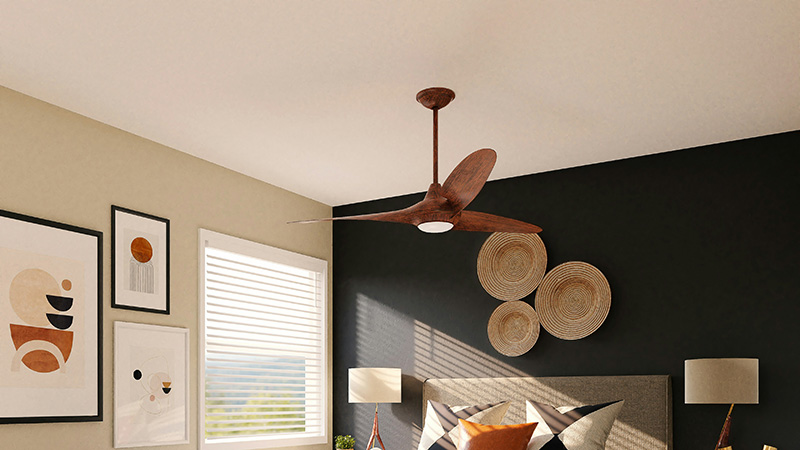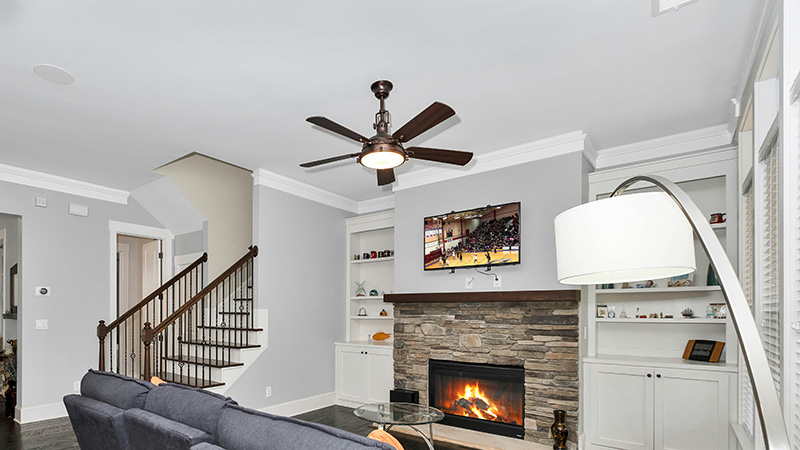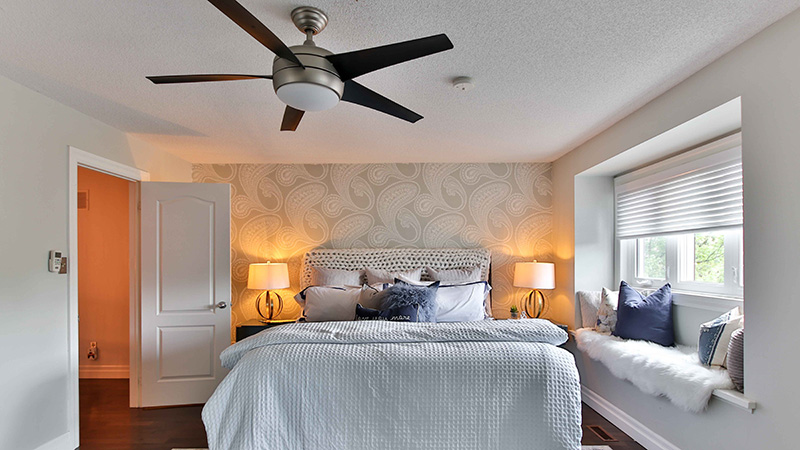If you are looking wholesale lighting solutions, click here.

Whether you’re a cost-conscious homeowner or an eco-conscious enthusiast looking to decrease your carbon footprint, ceiling fans are an excellent solution for all your cooling needs.
The accessibility and convenience of ceiling fans make it the default choice for most applications. However, alternate cooling solutions like air conditioning and window fans do a similar, if not better, job at cooling. Thus, it raises the question: why choose ceiling fans?
In this article, we break down the basics of ceiling fans and discuss the pros and cons of using a ceiling fan to cool your space.
The ceiling fan has an electric motor in the center that rotates at variable speeds. The motor is attached to fan blades that spin in an anti-clockwise direction. The fan blades are curved in such a way that on rotation, they pull air from the top (ceiling surface) of the fan and push it to the bottom (floor).
As the fans circulate air through the room, they create a cooling effect on the human body via the wind chill effect. The wind chill effect is a natural phenomenon where moving air removes heat from the body, lowering skin temperature. Additional cooling comes from body sweat evaporating from the airflow.
Therefore, it is clear that ceiling fans don’t actually cool the air and the room. Airflow makes the room feel cooler because it helps decrease our body temperature, but the ambient temperature of the room stays the same.

Now that we understand how a ceiling fan works, we can move on to its different variations.
Ceiling fan size is measured as the diameter of its blades’ coverage area. It is two times the distance of a fan blade edge from the center. Commercially available ceiling fans range from 29″ to 52″. Smaller fans move less air and are noisy.
Your average ceiling fan will have somewhere between three and six blades. Some rare designs have two or even one fan blade, but those options are stylistic and impractical. As the number of fan blades increases, so does its cooling efficiency.
Modern ceiling fans come in a wide range of materials. The blade material choice doesn’t directly improve the ceiling fan’s airflow. Alternative material choices are primarily sought for motor efficiency due to lower blade weight, overall cost, and design options.

Metal is the most common material for ceiling fan blades, with ABS (Acrylonitrile Butadiene Styrene) plastic and composites coming in at a close second and third place. Novelty materials like wood or MDF are less common and mostly preferred for their visual aesthetic.
Lights are another big addition to the standard ceiling fan design, Modern ceiling fans come with an LED light integrated at the center of the fan. A light and fan combo reduces the number of mounting holes in your ceiling, giving you a cleaner lighting design.
Ceiling fan-installed LEDs are a good ambient light source, especially in smaller, space-restricted rooms.
Finally, we have two basic design variations.
Ceiling fans are rated for three types of operating conditions.

Ceiling fans offer many advantages over other cooling solutions, from incorporating ambient lighting functionality into the design to reducing your energy bills.
Ceiling fans are incredibly efficient devices that offer decent cooling for a fraction of the energy. A standard 48″ ceiling fan consumes roughly 75 watts. In comparison, a 1-ton AC unit consumes 20 times more power at 1.5 kilowatts.
Additionally, air conditioners aren’t designed for houses with high ceilings. A lot of energy is wasted cooling empty space. In contrast, a ceiling fan installed with a download will directly and effectively cool the people underneath.
As ceiling fans are more energy efficient than an HVAC system, it should come as no surprise that they also reduce your energy costs. Houses in areas with high electricity costs will see even greater cost savings from limiting air conditioning use in favor of ceiling fans.

The biggest advantage of ceiling fans is their year-round usability. Ceiling fans are air circulation devices that can also be used in the winter. When heating a room, the warm air rises to the top and accumulates near the ceiling. Running a fan at slow speeds will result in the warm air being pushed down towards you.
Mold can grow in damp regions of a house. While air conditioning will keep your house cool, it will not dry those damp nooks and crannies. You need proper air circulation to ensure the space stays dry and mold-free.
Luckily, ceiling fans are designed to move lots of air around, preventing mold growth.
Ceiling fans fight environmental damage on two fronts. Firstly, they consume less energy, and this has a smaller carbon footprint. Secondly, unlike air conditioners that use dangerous refrigerants (known as hydrofluorocarbons), ceiling fans operate on the simple principles of electromagnetism.
Ceiling fans aren’t just for cooling a large room. They can also be deployed outside your house on the porch or patio. It is the one application where air conditioning can’t even match the performance of a ceiling fan.
Ceiling fans are very easy to install, requiring only a single mounting point on your ceiling. By comparison, central HVAC units require extensive ducting throughout the building, and standalone air conditioners require mounting and insulation for their outer unit.
No need to mess around with the thermostat setting or drilling through the walls. Simply add an anchor to your ceiling and mount your new ceiling fan.

It’s hard to list the cons of ceiling fans. They are general-purpose devices that are relatively inexpensive. Therefore, most of the shortcomings are outweighed by the low cost of the technology.
Ceiling fans don’t cool the air. Hence, they become significantly less useful on days of extreme heat. The fan circulates the hot air throughout the space, drying your skin while offering little to no cooling.
The electric motor inside a ceiling fan generates a lot of noise. The faster it spins, the more noise it generates. Most ceiling fans fall under the category of noisy operation. It is an unavoidable element of the technology.
Ceiling fans don’t always look good. Even with modern design options, they look out of place in most residential and commercial buildings. Manufacturers have taken several steps to counter this problem, such as using non-metal materials to change the look of ceiling fans.
Get a wooden fan blade model that fits into your rustic interior design. Remember, these fancy fan designs are also quite a bit expensive. Thus, you have a choice: save money by getting a simple, unappealing design, or spend a little extra and go for a premium and stylish ceiling fan.

Cleaning ceiling fans is a simple process made complicated by the installation location. While cleaning a ceiling only requires some water and a clean cloth, getting to the fan makes it infeasible for most.
You need to invest in a step ladder or hope you have a tall table to boost you. However, maintenance becomes even harder if you have a particularly high ceiling.
As ceiling fans are constantly pushing air with their blades, a lot of dust and grime gets sucked along. The coating of dirt on the fan can impact its aerodynamics, reducing overall cooling efficacy.
Ceiling fans offer a range of benefits, such as cost-effective cooling, being environmentally friendly, and ease of installation, making them a popular choice for most applications. Additionally, ceiling fans provide mold prevention through effective air circulation and are versatile enough for outdoor use.
Although ceiling fans lag behind air conditioning in terms of cooling performance, they more than makeup for it by being a practical choice for efficient and budget-friendly climate control.
Risun is revolutionizing efficiency and sustainability through a well-optimized Supply Chain Management system. In the expanse of the manufacturing sector, finding reliable and trustworthy partners is challenging.
Hence, we offer a One-Stop Solution, handling all the part sourcing, price negotiating, and quality certifications while you focus on your business.
Let Risun connect you with a top-notch ceiling fan manufacturer and supplier through our vast database of 300 collaborators. Give your business a second wind with Risun. Contact us Now!
Comprehensive Lighting Solutions for MRO Wholesalers and Professionals
send your inquiry
Hi, I'm the author of this post, and I have been in this field for more than 15 years. If you want to wholesale lighting fixtures or lighting related product, feel free to ask me any questions.
Learn More >>Download our catalog to view all of our lighting products.
Ready to get started ?
Send Your InquiryOur team will get back to you promptly

please
download
Get notified about new products
Our team will get back to you promptly!
Add your first comment to this post